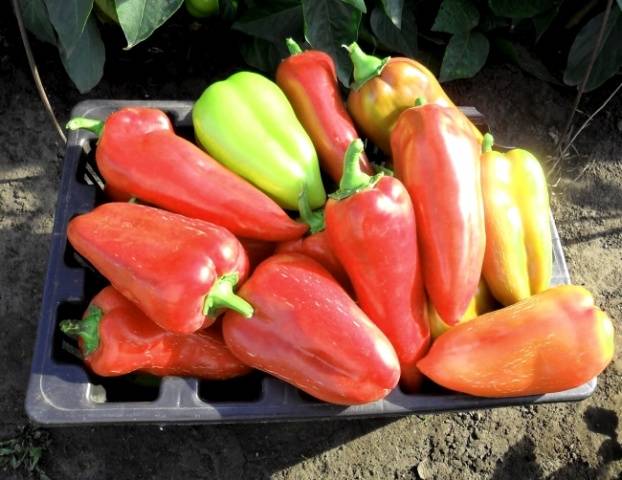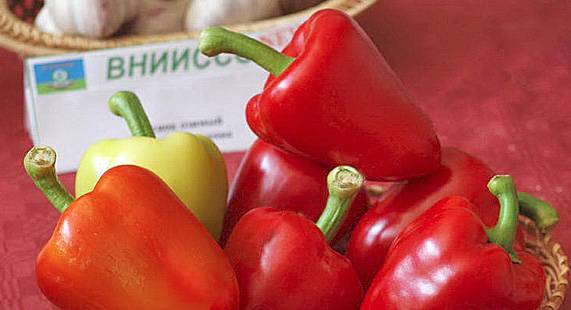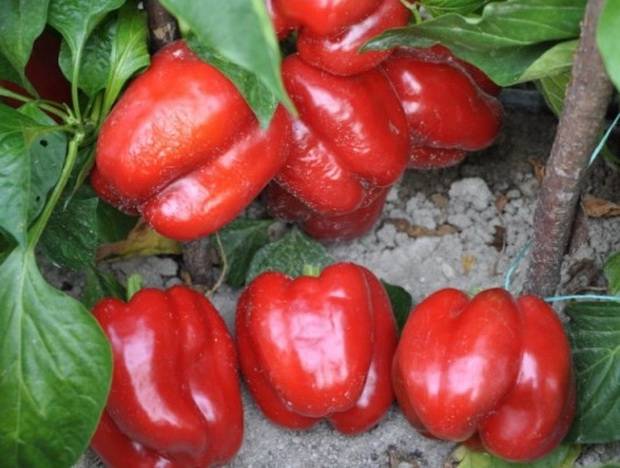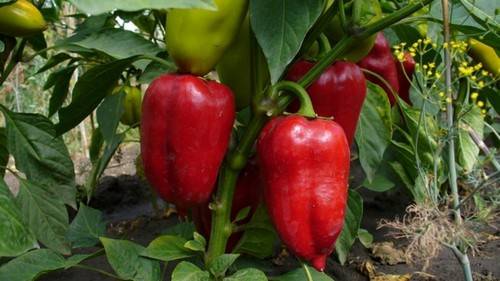Obtaining a good harvest depends not only on strict adherence to crop farming techniques, but also on the correct choice of variety. The crop must be acclimatized to the specific weather conditions of a particular region. Today we’ll talk about the varieties of peppers from the Northwestern region and learn the rules for choosing the most suitable crops.
What to consider when choosing varieties
When choosing a pepper variety or its hybrid, it is necessary to take into account the climate of the region where it will grow. For the North-West, it is optimal to choose early-ripening crops with low-growing bushes. If there is a greenhouse on the site, especially if it is heated, you can give preference to tall plants. A good harvest in such conditions can be obtained from mid-season and late hybrids that produce large, fleshy peppers.
Seedlings are planted in greenhouse soil 75 days after germination. The climate of the North-West is characterized by cloudy, cool weather until mid-March, so sowing seeds for seedlings must be done around February 15th.The choice of this sowing time is due to the fact that large peppers need 5 months to fully ripen. Thus, the first harvest can be harvested in mid-July.
There are two concepts: the stage of technical and biological maturity. In the first option, the peppers are usually green or white, still completely unripe, but ready to eat. In the second option, the fruits are considered fully ripe, having acquired a red or other color characteristic of a particular variety. So, the fruits of varietal crops must be picked in the first stage. In storage they will ripen on their own. It is better to harvest from Dutch hybrids when the peppers reach the second stage. At this time, they become saturated with sweet juice and a characteristic peppery aroma.
Dutch hybrids bear large, fleshy fruits late. To grow them in the North-West, you need to have a heated greenhouse, since the crop ripens in 7 months.
The most popular varieties in the Northwestern region are “Gift of Moldova” and “Tenderness”. They bear early fruits in closed ground with tender juicy pulp. But there are also many other varieties and hybrids of sweet peppers that have proven themselves well in cold regions.
Overview of varieties
Since we first started talking about the “Gift of Moldova” and “Tenderness” varieties, it is reasonable to consider them first, as the most popular. Next, let's get acquainted with other peppers of different ripening periods.
Tenderness
The culture is considered universal due to its ability to adapt to any climate. Bushes under cover grow up to 1 m in height, requiring branches to be tied up. The period of fruit ripening is considered mid-early. The first harvest is harvested 115 days after germination. The shape of the vegetable resembles a pyramid with a truncated top. The fleshy pulp, 8 mm thick, becomes rich red after ripening. A mature pepper weighs approximately 100 g. When grown in greenhouses, the yield is 7 kg/m2.
Gift from Moldova
The plant produces a harvest of ripe peppers 120 days after germination, which classifies it as a mid-early variety. Low bushes grow to a maximum of 45 cm in height and are compactly folded. Cone-shaped peppercorns have an average pulp thickness of about 5 mm, covered with smooth skin. When ripe, the light flesh turns red. The weight of a mature vegetable is approximately 70 g. The yield is good, per 1 m2 You can harvest about 4.7 kg of peppers.
Chrysolite F1
After seedling germination, the first mature harvest will appear in 110 days. The culture belongs to early hybrids and is intended for greenhouse cultivation. The tall plant is not very covered with foliage, the branches are spreading, requiring garter. Large fruits with slightly visible ribbing inside form 3 or 4 seed chambers. The pulp is juicy, 5 mm thick, covered with smooth skin, and turns red when ripe. The weight of mature pepper is about 160 g.
Agapovsky
The greenhouse crop produces an early harvest approximately 100 days after seedling germination.Medium-sized bushes are densely covered with foliage, the crown is compact. The shape of the vegetable resembles a prism; ribbing is slightly visible along the walls. Up to 4 seed nests are formed inside. When ripe, the green flesh turns red. Ripe peppers weigh approximately 120 g. The fleshy pulp, 7 mm thick, is highly saturated with juice. The yield of the variety is high, from 1 m2 10 kg of vegetables are collected.
Ruza F1
The fruits of this early hybrid ripen in greenhouse conditions 90 days after germination. A tall bush with medium foliage. Cone-shaped peppers with smooth skin and slightly visible ribbing acquire a red color on the walls when ripe. The fruits hang drooping on the branches of the bush. Under a cold shelter, peppercorns grow smaller, weighing about 50 g. A hybrid grown in a heated greenhouse produces larger fruits weighing up to 100 g. The pulp is juicy, 5 mm thick. In greenhouse conditions of the North-Western region from 1 m2 you can collect 22 kg of vegetables.
Bullfinch F1
Another indoor hybrid produces early harvests in 105 days. However, full ripening of peppers occurs after 120 days. The plant is very tall, usually growing 1.6 m in height, sometimes stretching up to 2.1 m. The bush is compact, medium covered with foliage with drooping peppercorns. The shape of the vegetable resembles a slightly curved prism with a rounded top. The ribbing is slightly visible on the smooth skin. Inside the red pulp, 6 mm thick, 2 or 3 seed chambers are formed. The maximum weight of a ripe peppercorn is approximately 120 g.
Mazurka F1
In terms of ripening time, the hybrid belongs to the mid-early peppers.The crop is intended for greenhouse cultivation and produces the first harvests after 110 days. The bush grows to medium height with limited shoots. The shape of the vegetable is a bit like a cube, where three seed chambers are usually formed inside. The smooth skin covers the fleshy flesh 6 mm thick. A mature pepper weighs about 175 g.
Pinocchio F1
The hybrid intended for greenhouse purposes brings an early harvest, 90 days after the emergence of seedlings. The bush grows a little more than 1 m in height with short side branches. Usually the plant forms no more than three shoots. The cone-shaped vegetable has slight ribbing and turns red when ripe. The tasty juicy pulp, 5 mm thick, is covered with a strong, smooth skin. A mature pepper weighs about 110 g. The hybrid produces large yields. From 1 m2 you can harvest more than 13 kg of vegetables.
Spring
A variety of peppers for greenhouse cultivation produces an early harvest 90 days after seedling germination. The tall bush has slightly spreading branches. The cone-shaped peppercorns are covered with a smooth skin, along which the ribbing is faintly visible. As the green color matures, the walls turn red. The pulp is aromatic, juicy, up to 6 mm thick. A mature vegetable weighs a maximum of 100 g. The variety is considered high-yielding, yielding more than 11 kg of peppers per 1 m2.
Fiery F1
The greenhouse-intended hybrid produces an early harvest 105 days after complete germination of seedlings. Tall bushes usually grow 1.4 m in height, but can stretch up to 1.8 m. The plant is not heavily covered with foliage.Peppers, shaped like a prism, have weak ribbing, plus there is wavyness along the walls. After full ripening, the green flesh turns red. 2 or 3 seed chambers are formed inside the vegetable. The pulp is aromatic, juicy, 6 mm thick. Weight of mature pepper is maximum 100 g.
Mercury F1
After 90-100 days, the hybrid will bring an early harvest of peppers in greenhouse conditions. The bushes grow to an average height of just over 1 m with two or three shoots. The crown is spreading and requires tying to the trellis. Cone-shaped peppercorns with rounded tops weigh approximately 120 g. The dense pulp, 5 mm thick, is covered with a durable, smooth skin. The hybrid is considered high-yielding, yielding from 1 m2 about 12 kg of vegetables.
Pilgrim F1
The greenhouse hybrid belongs to the average ripening period, bearing the first fruits after 125 days. The bushes are tall, but compact and require partial staking of the stems. Cuboid-shaped peppers are characterized by a blunt, slightly pressed inward tip. The skin of the fruit is smooth, with slight waviness along the walls. 3 to 4 seed chambers are formed inside. After ripening, the green flesh of the vegetable, about 7 mm thick, turns red. A mature peppercorn weighs 140 g.
Lero F1
The crop is intended for growing in closed beds. The hybrid can produce its first harvest after 90 days. Tall bushes have a compact shape and require partial staking of the crown. The peppercorns are shaped like a heart and have up to three seed chambers inside. The fleshy, juicy pulp, about 9 mm thick, is covered with a smooth skin. After ripening, the green walls become red in color. A mature vegetable weighs 85 g.
The video shows the selection of varieties:
Lumina
A long-known and popular variety with low-growing bushes produces larger fruits weighing 115 g in the first wave of harvest. All subsequent peppers grow smaller, weighing no more than 100 g. The shape of the vegetable is cone-shaped, slightly elongated with a sharp nose. The pulp is thin, no more than 5 mm thick, and when ripe is beige in color with a pale greenish tint. The peppers taste good without a pronounced aroma or sweet aftertaste. The plant is undemanding in care and adapts to different climatic conditions. The harvested crop can be stored for up to three months.
Ivanhoe
This variety was developed recently, but has already gained popularity among many vegetable growers. Cone-shaped fruits with fleshy walls 8 mm thick when ripe acquire a rich orange or red color. A ripe peppercorn weighs about 130 g. Inside the vegetable has 4 seed chambers, abundantly filled with grains. Compact, medium-sized bushes must be tied to at least wooden stakes. The harvested crop can be stored for 2 months without losing its presentation.
Marinka's tongue
The culture has increased adaptation to aggressive climatic conditions and poor soils. Giving the plant little care, it will still reward you with a generous harvest. The bushes grow to a maximum height of 0.7 m. The crown is very spreading, requiring mandatory garter. Cone-shaped, slightly curved peppers weigh about 190 g. The 1 cm thick flesh has a characteristic crunch. After full ripening, the vegetable becomes red with a cherry tint. The harvested crop can be stored for 1.5 months.
Triton
A very early variety is capable of producing a good harvest in Siberian conditions if grown in greenhouses. The plant does not mind the lack of sunny warm days; it is not bothered by prolonged rains and cold weather. The bushes grow compact and medium in size. Cone-shaped peppers weigh a maximum of 140 g. The pulp is juicy. 8 mm thick. Once ripe, the vegetable turns red or yellow-orange in color.
Eroshka
An early-ripening variety of pepper bears medium-sized fruits weighing about 180 g. Neatly folded bushes grow no more than 0.5 m in height. The pulp is juicy, but not too fleshy, only 5 mm thick. According to its intended purpose, the vegetable is considered a salad type. The plant bears fruit well when planted densely. The harvested crop is stored for 3 months.
Funtik
Another popular variety has a compact bush structure up to 0.7 m high. For reliability, it is advisable to tie the plant. Cone-shaped peppercorns with a pulp thickness of 7 mm weigh approximately 180 g. The fruits are almost all smooth, sometimes there are specimens with a curved nose. The vegetable tastes sweet with a peppery aroma. The harvested crop is stored for a maximum of 2.5 months.
Czardas
The popularity of the variety is due to the color of its fruits. As they ripen, the colors range from lemon to deep orange. Cone-shaped peppers with a pulp thickness of 6 mm grow weighing approximately 220 g. The height of the bushes is a maximum of 0.6 m. The vegetable is very tasty, even when picked at the stage of technical ripeness. The harvested crop is stored for 2 months.
cabin boy
Low-growing bushes with a maximum height of 0.5 m produce excellent yields when planted densely. The vegetable can be eaten green, only its watery pulp is slightly aromatic and practically unsweetened. These peppercorns weigh approximately 130 g.A ripe vegetable adds a little weight, acquires a sweetness and peppery aroma. The flesh turns red. The cone-shaped fruits can be stored for 2.5 months.
Conclusion
The video shows growing peppers in cold climates:
In addition to the crops discussed, there are a huge number of other varieties of early peppers that can bear fruit in the greenhouse conditions of the North-West. And if there is still heating, a good harvest is guaranteed.


























